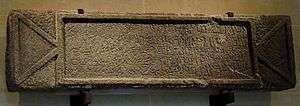Shammar Yahri'sh
Shammar Yahri'sh full name (Shammar Yahr'ish b. Yasir Yun'im b. 'Amr Dhu'l-Adh'ar) (Arabic: شَمَّر يرعش, "Shammar trembles") was a Himyarite king.[1] It is believed He conquered The Levant (Syria,Palestine). Its also believed He Subjugated The kingdom of Israel and Persia and reached as far as The Tibet.[1] It is also believed he invaded Northern India and gained lots of Loot. His Father King Nasher An'em conquered Egypt And reached as far as the Strait of Gibraltar.[1][2][3]
Life

In AD 275, he led his troops to victory over Najran, Ma'rib (the Sabeans later reconquered their capital) and Hadhramaut. He succeeded in uniting much of Yemen, assuming the title "King of Saba and Dhu Raydan and Hadhramaut and Yamnat" (Yamnat may have been the name of the Southern part of Yemen). From his time forward the Himyarite kings were known as "Tubba kings", and praised for their courage and leadership in traditional Yemeni poetry. Shamar name was recorded in Namara inscription.
Legacy
In about 280 AD, Shammar Yuharʿish, residing at his capital Ẓafār, united Yemen under his rule.[4] One hundred years later Abu Karib Asad, who was nicknamed "Asad al-Kamel" (the perfect one) fulfilled the highest aspirations of Shammar Yuharish. Under his leadership the old Sabaean Kingdom with Ma'rib as the capital was conquered and ceased to exist as an independent kingdom. The Axumites, who had become a strong power and had occupied the Tihamah and part of the highlands more than once, were driven back to Ethiopia. During his rule pre-Islamic Yemen probably reached its greatest expansion including southern parts of present Saudi Arabia and Oman as a whole.
See also
. Shammar tribe
References
- 1 2 3 Ibn Ishaq; Guillaume (1955). The Life of Muhammad: A Translation of Ibn Isḥāq’s sīrat. London. p. 694. ISBN 0195778286.
- ↑ Gordon, Matthew S.; Robinson, Chase F.; Rowson, Everett K.; Fishbein, Michael (2017-12-07). The Works of Ibn Wāḍiḥ al-Yaʿqūbī (Volume 2): An English Translation. BRILL. ISBN 9789004364158.
- ↑ Balfour, Edward (1885). The Cyclopaedia of India and of Eastern and Southern Asia, Commercial, Industrial and Scientific; Products of the Mineral, Vegetable and Animal Kingdoms, Useful Arts and Manufactures. B. Quaritch.
- ↑ Marx, edited by Angelika Neuwirth, Nicolai Sinai, Michael (2010). The Qur'an in context historical and literary investigations into the Qur'anic milieu (PDF). Leiden: Brill. p. 53. ISBN 9789047430322. Archived from the original on 2010.